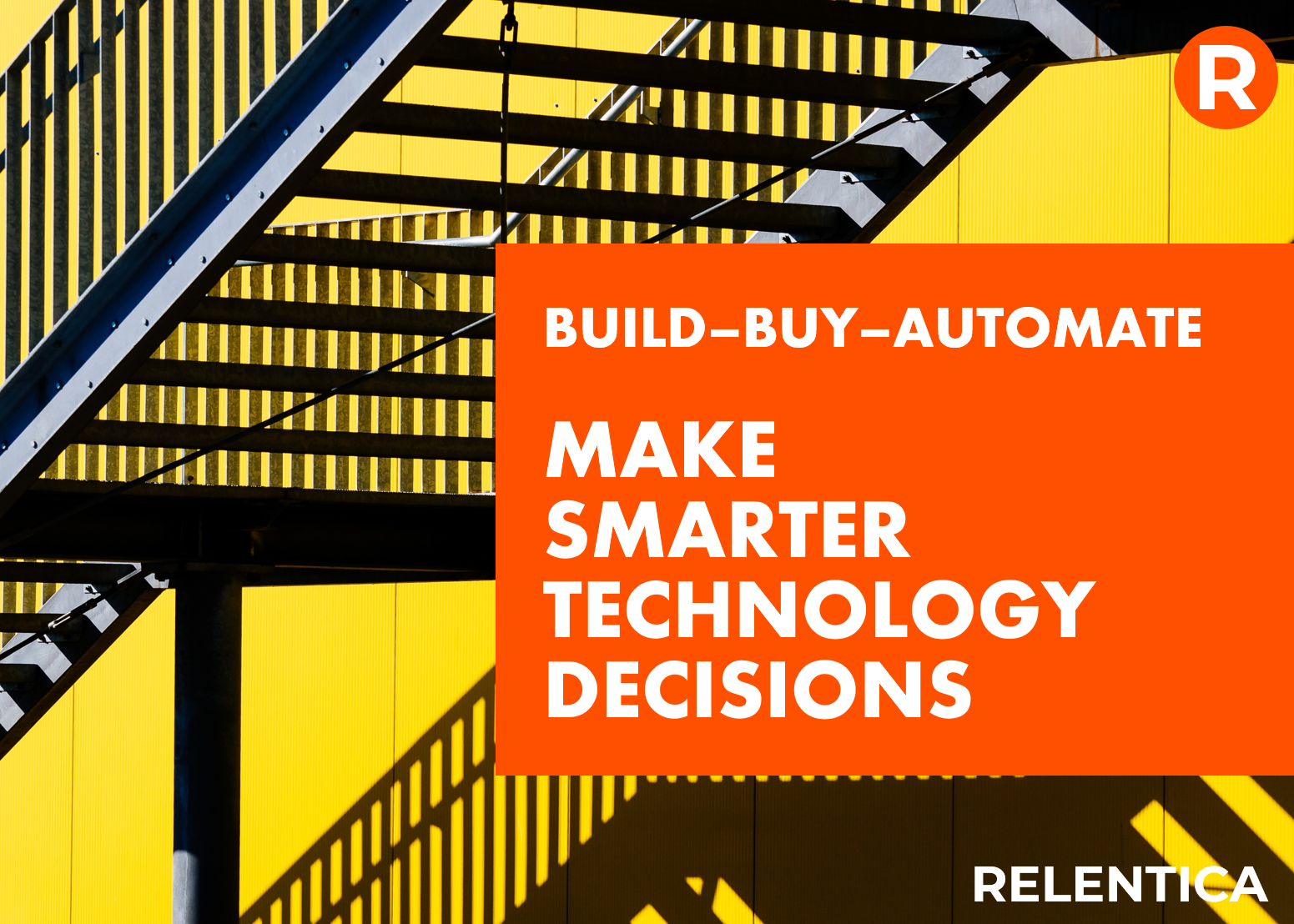
The question of whether to build, buy, or automate is one of the most deceptively simple decisions in technology. It appears straightforward, yet it is anything but. This choice is always contextual and always shaped by the organisation’s commercial priorities, operational maturity, and appetite for complexity. It is a question that forces leaders to confront what they understand about their business – and what they do not.
At Relentica, we anchor this decision in a single guiding principle: every technology choice must support one or more of the three commercial outcomes that matter. Organisations must grow revenue, drive margin, and reduce risk. Everything else is noise. When leaders approach the build–buy–automate question through this lens, the right decision becomes clearer and the distractions fall away.
The Real Challenge: Noise, Preference and Pressure
The complexity of this decision rarely comes from technology itself. It comes from competing opinions. Technology teams often want to build because it is part of their identity and craft. Leaders who are excited by innovation often want to automate because it feels modern. SaaS vendors make buying new platforms appealing, particularly when the promise of embedded AI is involved. Each perspective can be valid, but each can also create unnecessary complexity when not grounded in commercial reality.
Simplicity is one of the most undervalued strategic levers in modern organisations. Simple architectures are easier to secure, cheaper to operate, easier to maintain, and faster to adapt. Complexity reduces pace, increases cyber exposure, weakens operational resilience, and expands cost. Leaders who make decisions without understanding this trade-off risk accumulating technology that feels impressive but delivers little meaningful value.
When Building Makes Sense
There are only two scenarios in which building is the right decision. These situations are far narrower than many assume.
The first is when the technology in question is the core intellectual property of the business. When the platform or product defines the organisation’s value proposition, differentiation, customer experience, or revenue stream, it must be built and owned internally. Ownership creates control – over innovation, evolution, security, resilience, and commercial structure. No third-party vendor will ever shape their roadmap to match yours.
The second scenario is when an organisation already uses a bought platform that does almost everything required, but a small, highly targeted extension is needed to close a specific capability gap. These are intentional, contained builds. They are designed to fit neatly into the surrounding ecosystem without creating a shadow product.
In both cases leaders must think ahead. Anything built today must support future automation, future data needs, and future AI enablement. A build that cannot evolve becomes legacy on the day it launches.
The Case for Buying – And the Watch-Points Leaders Cannot Ignore
Buying, particularly through SaaS, is attractive for good reason. It is fast, simple, cost-efficient, and feature-rich out of the box. It allows organisations to adopt capability quickly and benefit from continuous vendor-led innovation.
However, buying carries a long-term cost model that leaders must understand clearly. Licence commitments renew whether the platform is used effectively or not. Costs increase year after year. AI features vary wildly in their maturity and integration quality. And while SaaS is simple to adopt, the long-term value depends entirely on how well it is embedded.
Leaders must understand two things: the total cost of ownership over several years, and the operational commitment required to extract value. Supplier management, user adoption, compliance, and roadmap awareness are not optional disciplines. They are the mechanisms through which purchased technology delivers value rather than shelfware.
Buying is often the right answer – but only when organisations invest enough time and discipline to use what they have paid for.
Automation: High Value, High Consequence
Automation has advanced significantly, particularly with AI-enabled tools that accelerate or enhance process execution. But automation remains a double-edged sword. It amplifies whatever exists beneath it.
If a process is stable, documented, and clearly owned, automation can remove manual effort, increase accuracy, and release capacity. If a process is unclear, frequently changing, or poorly governed, automation creates fragility. It introduces hidden dependencies, increases operational risk, and breaks at the worst possible moment.
Leaders must ensure processes are properly understood before automation is introduced. Basic documentation, ownership clarity, and alignment with central IT tooling are essential. Rogue automation may seem agile in the short term, but over time it becomes a liability.
Automation works best when it is applied deliberately, monitored consistently, and supported by an organisation that understands its processes as well as its tools.
The Common Thread: Know Your Business
Every build–buy–automate decision ultimately reflects how well an organisation understands itself. Leaders must be clear on how the business operates, how value flows, where constraints sit, how processes connect, and where change creates risk or opportunity.
Cost clarity is equally important. Leaders must consider not only the initial investment but also the long-term implications. Building creates ongoing maintenance, talent dependency, and continuous evolution. Buying creates multi-year financial commitments and vendor dependency. Automation creates oversight obligations, monitoring requirements, and support needs.
Decisions should always look beyond the first twelve months. Leaders must ask whether a choice made today will still make sense in two years, five years, or ten.
Making the Right Choice
There is no universal answer. There is only the right answer for your organisation, at this moment, given your goals, constraints, and operating model.
Building makes sense when the technology defines your commercial identity or when a bought platform requires a small, targeted extension.
Buying makes sense when SaaS simplifies your ecosystem, accelerates capability, and can be adopted and governed effectively.
Automation makes sense when processes are stable, well understood, and important enough to justify the discipline required to support them.
Strong leaders look beyond slogans. They look at commercial outcomes. They evaluate decisions through the lens of revenue, margin, and risk. They prioritise simplicity, understand their processes, and make decisions that serve the long-term interests of the organisation.
The organisations that excel are those that make technology choices deliberately, consistently, and with discipline. The ones that struggle are those that conflate enthusiasm with strategy.
Relentica’s approach to automation and technology leadership is grounded in this reality. Decisions made today must support the business you want to become tomorrow. And for most organisations, that begins not with building, buying, or automating – but with clarity.








